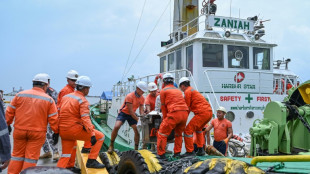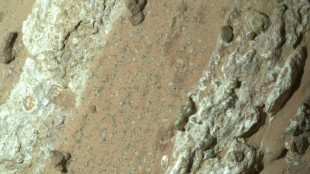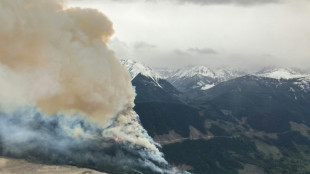
-
 US defends law forcing sale of TikTok app
US defends law forcing sale of TikTok app
-
Messi out for defending champ Miami as Leagues Cup begins

-
 Australia bans uranium mining at Indigenous site
Australia bans uranium mining at Indigenous site
-
Divers attempt to reach sunken Philippine oil tanker

-
 Trump accuses Harris of anti-Semitism in overblown speech
Trump accuses Harris of anti-Semitism in overblown speech
-
Coughlin clings to lead at LPGA Canadian Women's Open

-
 Trump offers tech sector policy flips ahead of election
Trump offers tech sector policy flips ahead of election
-
Spacecraft to swing by Earth, Moon on path to Jupiter

-
 What's the fallout of Mexican drug lords' capture?
What's the fallout of Mexican drug lords' capture?
-
Video game makers see actors as AI 'data,' says union on strike

-
 Chinese qualifier Shang to face Thompson in ATP Atlanta semis
Chinese qualifier Shang to face Thompson in ATP Atlanta semis
-
'Massive attack' on French rail threatens more chaos

-
 'We did it!': France breathes sigh of relief after Olympics ceremony
'We did it!': France breathes sigh of relief after Olympics ceremony
-
Regional concern grows as Venezuela blocks vote observers

-
 Historic river parade, Dion show-stopper ignite Paris Olympics
Historic river parade, Dion show-stopper ignite Paris Olympics
-
Rainy Paris Olympic parade dampens many spectators' spirits

-
 The one of a kind Paris opening ceremony: five memorable moments
The one of a kind Paris opening ceremony: five memorable moments
-
Justin Timberlake seeks to dismiss DUI case

-
 Warner Brothers Discovery sues NBA over Amazon rights deal
Warner Brothers Discovery sues NBA over Amazon rights deal
-
Kobe Bryant locker, Maradona jersey up for auction in New York

-
 Historic river parade launches Paris Olympics
Historic river parade launches Paris Olympics
-
New York family of Holocaust victim reclaims Nazi-looted art

-
 NASA Mars rover captures rock that could hold fossilized microbes
NASA Mars rover captures rock that could hold fossilized microbes
-
Thousands evacuate season's biggest wildfire in northern California

-
 Ethiopia mourns victims of landslide tragedy
Ethiopia mourns victims of landslide tragedy
-
Lady Gaga adds sparkle to star-studded Olympic show

-
 Airbus and Boeing supremacy secure despite turbulence
Airbus and Boeing supremacy secure despite turbulence
-
Teams sail down Seine in rain-soaked Olympics opening ceremony

-
 West Indies' treble strike rocks England in third Test
West Indies' treble strike rocks England in third Test
-
Olympic opening ceremony under way on River Seine

-
 Mott's England future uncertain as ECB chief fails to offer support
Mott's England future uncertain as ECB chief fails to offer support
-
Trump meets Israeli PM Netanyahu in Florida

-
 S.African police say 95 Libyans detained at suspected military camp
S.African police say 95 Libyans detained at suspected military camp
-
Blinken set for talks with Chinese counterpart in Laos

-
 Norris heads Piastri in McLaren one-two at Belgian GP practice
Norris heads Piastri in McLaren one-two at Belgian GP practice
-
G20 seeks common ground on taxing super-rich

-
 European medicines watchdog rejects new Alzheimer's drug
European medicines watchdog rejects new Alzheimer's drug
-
Habib, Ebden eye Alcaraz and Djokovic shocks at Olympics tennis

-
 Long queues, ticketing problems ahead of Paris opening ceremony
Long queues, ticketing problems ahead of Paris opening ceremony
-
Two Sinaloa Cartel leaders face US charges after stunning capture

-
 Spain train driver jailed for 2.5 years over deadly 2013 crash
Spain train driver jailed for 2.5 years over deadly 2013 crash
-
Paris poised for Olympic opening ceremony spectacular

-
 Judoka fails doping test in first case at Paris Olympics
Judoka fails doping test in first case at Paris Olympics
-
Holder and Da Silva keep England at bay after West Indies collapse

-
 Alpine F1 boss Bruno Famin to leave in August
Alpine F1 boss Bruno Famin to leave in August
-
Ethiopia declares three days of mourning after landslide tragedy

-
 Brazilian dunes dotted with dazzling pools make UNESCO heritage list
Brazilian dunes dotted with dazzling pools make UNESCO heritage list
-
Rain, cooling slow huge blaze in Canada's Jasper park

-
 French Rugby's Jaminet suspended 34 weeks after racist video: Federation
French Rugby's Jaminet suspended 34 weeks after racist video: Federation
-
Osaka looking to turbo-charge comeback at Paris Olympics


Ex-heavyweights resurrected in Costa Rica polls, but election still unclear
There is a feeling of uncertainty hanging over one of Latin America's most stable democracies as Costa Rica heads to the polls on Sunday with a crowded presidential field and no clear favorite.
Often referred to as the region's "happiest" country, Costa Rica is nonetheless grappling with a growing economic crisis and the ruling Citizen's Action Party (PAC) is set for a bruising defeat.
The economy has tanked under the progressive program of President Carlos Alvarado Quesada and the PAC candidate, former economy minister Welmer Ramos, seems to be paying the price for sky-high anti-government feeling, polling just 0.3 percent.
"The ruling party is completely weakened and has no chance" after two successive terms of office, said political analyst Eugenia Aguirre.
"The presidential unpopularity figure of 72 percent is the highest since the number was first recorded in 2013," she added.
It means the country's traditional political heavyweights -- the centrist National Liberation Party (PLN) and the right-wing Social Christian Unity Party (PUSC) -- could return to the fore.
According to one poll published this month, former president Jose Maria Figueres (1994-98) of the PLN leads with just over 17 percent, while PUSC's Lineth Saborio is on just under 13 percent.
Until PAC's Otton Solis reached the second round run-off in 2006, the PLN and PUSC had enjoyed decades of a near political duopoly.
To win outright in Sunday's first round, a candidate needs 40 percent of the vote, otherwise there will be a run-off on April 3 between the top two.
Costa Rica is known for its eco-tourism and green policies: its energy grid is 100 percent run on renewable sources.
Unlike many of its volatile neighbors, Costa Rica has no army, has had no armed conflicts since 1948 and no dictator since 1919.
But the worsening economic situation has hit confidence in the political class. And with 25 presidential candidates, more than 30 percent of the 3.5 million voters are undecided.
Despite the country's stable reputation, voters under 40 have only known "periods in which not only problems have not been resolved, but they have worsened," university student Edgardo Soto, who says he does not know who to vote for, told AFP.
Unemployment has been steadily rising for more than a decade and sat at 14.4 percent in 2021.
Poverty reached 23 percent in 2021 with debt now a staggering 70 percent of GDP.
"If someone expects to find a bed of roses, that won't be the case with this government," Saborio, 61, told AFP.
"Costa Rica is in a moment of social, economic and political crisis."
- Pent-up frustrations -
Apathy and abstentionism have always been issues in Costa Rica's elections. In 2018 the abstention rate was over 34 percent.
With so many undecided, Costa Rica's opinion polls can be notoriously poor reflections of what will happen in an election.
In 2018, Alvarado Quesada was running sixth with 5.6 percent in polls but ended up beating evangelical Christian singer Fabricio Alvarado Munoz by 20 points in the run-off. Quesada cannot stand for re-election.
Alvarado Munoz, of the right-wing New Republic Party (PNR), was third in this month's poll with a little over 10 percent.
He commands loyal support from the Christian community, which makes up around 20 percent of Costa Rica's five million population.
In fourth is economist Rodrigo Chaves of the newly formed centrist Social Democratic Progress Party, on eight percent, with the top left-wing candidate Jose Maria Villalta of the Broad Front on 7.5 percent.
Figueres, 67, says the crowded field "is a reflection of this whole frustration that has built up."
"If there are 25 options it is because the parties are not understanding the needs of a society that is changing before their eyes."
Not everyone is feeling blue ahead of the poll.
"I understand why the people are distrustful ... they have been cheated for years. But this time there is more hope," said Chaves.
F.Ferraz--PC
